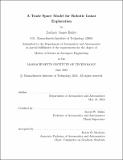| dc.contributor.advisor | David W. Miller. | en_US |
| dc.contributor.author | Bailey, Zachary James | en_US |
| dc.contributor.other | Massachusetts Institute of Technology. Dept. of Aeronautics and Astronautics. | en_US |
| dc.date.accessioned | 2010-10-29T13:49:05Z | |
| dc.date.available | 2010-10-29T13:49:05Z | |
| dc.date.copyright | 2010 | en_US |
| dc.date.issued | 2010 | en_US |
| dc.identifier.uri | http://hdl.handle.net/1721.1/59552 | |
| dc.description | Thesis (S.M.)--Massachusetts Institute of Technology, Dept. of Aeronautics and Astronautics, 2010. | en_US |
| dc.description | This electronic version was submitted by the student author. The certified thesis is available in the Institute Archives and Special Collections. | en_US |
| dc.description | Cataloged from student submitted PDF version of thesis. | en_US |
| dc.description | Includes bibliographical references (p. 147-152). | en_US |
| dc.description.abstract | The last decade has seen a resurgence of interest in the moon as a target for planetary exploration. In light of the growing interest in the robotic exploration of the moon, this thesis presents a quantitative methodology for exploring the trade space of potential in situ robotic lunar spacecraft designs. A science value model was developed, using Multi-Attribute Utility Theory (MAUT), to estimate the effectiveness of a spacecraft design towards assessing a set of specified science objectives. An engineering model was developed to estimate the masses of spacecraft designs within the trade space. These models were integrated together to explore the objectives of minimizing mass and maximizing science return. Two methods for exploration of the trade space were presented: a stochastic design space search method, and a multi-objective simulated annealing method. Using these techniques, the optimality of a reference mission was investigated, and ways to improve science utility performance were shown. The exploration of a trade space under uncertainty, using an -Pareto search method, was investigated, and recommendations for designers were presented. | en_US |
| dc.description.statementofresponsibility | by Zachary James Bailey. | en_US |
| dc.format.extent | 152 p. | en_US |
| dc.language.iso | eng | en_US |
| dc.publisher | Massachusetts Institute of Technology | en_US |
| dc.rights | M.I.T. theses are protected by
copyright. They may be viewed from this source for any purpose, but
reproduction or distribution in any format is prohibited without written
permission. See provided URL for inquiries about permission. | en_US |
| dc.rights.uri | http://dspace.mit.edu/handle/1721.1/7582 | en_US |
| dc.subject | Aeronautics and Astronautics. | en_US |
| dc.title | A trade space model for robotic lunar exploration | en_US |
| dc.type | Thesis | en_US |
| dc.description.degree | S.M. | en_US |
| dc.contributor.department | Massachusetts Institute of Technology. Department of Aeronautics and Astronautics | |
| dc.identifier.oclc | 668108280 | en_US |
